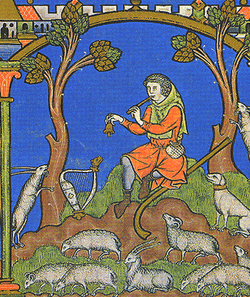Three-hole pipe
 | |
| Other names | Galoubet, Schwegel, Schwiegel, Swegel, Tamerlinpfeife, Tämmerinpfeife |
|---|---|
| Classification | |
| Playing range | |
| 1-2 octaves | |
| Related instruments | |
The three-hole pipe, also commonly known as tabor pipe is a wind instrument designed to be played by one hand, leaving the other hand free to play a tabor drum, bell, psalterium or tambourin à cordes, bones, triangle or other percussive instrument.
The three-hole pipe's origins are not known, but it dates back at least to the 11th century.[1]
It was popular from an early date in France, the Iberian Peninsula and Great Britain and remains in use there today.[2] In the Basque Country it has increasingly gained momentum and prestige during the last century, especially during the last years of Franco's dictatorship, following that it turned into a hallmark of Basque identity and folk culture. New pipe and tabor schools have cropped up since throughout the country, providing along with tabor the musical background for traditional Basque dance ensembles (see txistu). In Andalusia these pipes (flauta or gaita and the tambor or tamboril) are played in celebrations, Cruces de Mayo, sword dances[3] and romerías; in the music used around Romería of El Rocío (Huelva, Andalucía) this same pipe is denominated flauta rociera, gaita rociera or sometimes pito rociero (a higher pitched whistle).
The most common form of tabor pipe in the Basque region is tuned "tone, semitone, tone", as in the pipe of Andalusia.[4] The most common form in Provence is tuned "tone, tone, tone". The English tabor pipe is commonly tuned "tone, tone, semitone", and corresponds to the three lowest holes of a tinwhistle.[2]
See also
- Fipple
- Flabiol
- Flageolet
- Fujara
- Galoubet
- Jacques de Vaucanson
- Morris dance
- Picco pipe
- Pipe and tabor
- Txistu
- Zuffolo
References
- ↑ The Taborer's Society
- 1 2 The Pipe and Tabor Worldwide Archived September 8, 2007, at the Wayback Machine.
- ↑ "DANZAS DE ESPADAS Y TOQUES DE TAMBORIL EN LA SIERRA Y EL ANDÉVALO ONUBENSES (PDF Download Available)". ResearchGate. Retrieved 2017-03-16.
- ↑ "Flauta y tamboril. Gaita de Huelva, gaita rociera, gaita andaluza". postmusicas. Retrieved 2017-03-16.
External links
- The Taborers' Society
- A Plain and Easy Introduction to the English Pipe and Tabor
- Address to a Society of Morris Dancers, 1914 by Sir Francis Darwin